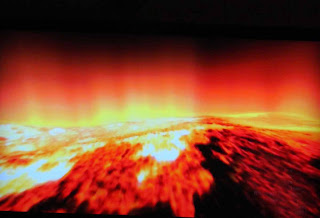Yesterday it was raining with temperatures in the mid 30s. In fact, it was raining hard. It condensed and partially melted the little bit of snow we have But then when I woke this morning, I looked out to a white out. From day to day this winter it is hard to tell what to expect.
So I did not get out since I refuse to go out in that type of weather. So for today's blog posting, I am including a series of interesting photos. Please check them out and guess what you think they are. Some of the photos are not obvious, but the exercise of guessing will hopefully stimulate your thoughts. At the end of this posting, included is information about what the pictures in fact represent.
Photo 1
Photo 2
Photo 3
Photo 4
Photo 5
Photo 6
Photo 7
Photo 8
Photo 9
Photo 10
Photo 11
Photo 12
Photo 13
Photo 14
All of the pictures were taken from the Science Channel's program called How The Universe Works. The timing of the show was perfect for me since I have been working on my speech for the Celebration of Agates international show coming up the end of July in Minneapolis, MN. My speech's title is: The Story of Silica--Cosmic Source through Agate Genesis.
Photo 1 Simulation of the beginning of an exploding supernova
Photo 2 A cosmic structure formed by a giant wall of galaxies, called a galactic filament. It is the
largest known structure in the universe. Scientists have been mapping the known universe using specialized equipment to measure cosmic microwave background radiation. They were surprised that all of the galaxies in the universe a connected in a filament arrangement.
Photo 3 A simulation of the impact point of an early planet building collision.
Photo 4 An illustration of the earth's magnetic field.
Photo 5 A simulated picture of a star that is five million times larger than our sun, which is nearly a million miles in diameter and 93,000,000 miles away from the earth. You can fit a million earths inside our sun. There are other stars that are even bigger. The largest star ever discovered is VY Canis Majoris, which is a billion times larger than our sun. It is located 4,900 light years away.
Photo 6 A nebula, which is left over star dust from the death of a large star that exploded in a supernova.
Photo 7 A simulation of what it looks like on the surface of our sun.
Photo 8 The active zone in a man-made fusion reactor Scientists are simulating a star's energy source -- in a lab near Oxford, England -- to control the power of fusion.
Photo 9 A simulated picture of photons created in the fusion of hydrogen atoms. These atoms naturally repel each other. But if you heat them up, such as what happens in the core of a star, heat equals motion. When the atoms move fast enough, they cannot avoid hitting each other and they hit and fuse to create a new element -- helium -- along with a small amount of pure energy released as photons.
Photo 10 A simulated picture showing photons escaping from the surface of the sun. It takes thousands of years for photons to travel from the core of the sun to the surface. It then just takes eight minutes for photons to travel from the surface of the sun to the earth.
Photo 11 A simulated picture showing the declining fusion in the center of a sun near the end of its life cycle.
Photo 12 When a small star, like our sun, uses up all its hydrogen in the fusion reactions, there is not enough outward pressure. Gravity trying to get the star to contract will win the war against the fusion reactions that try to explode the star outward. At first, gravity will crush the star in on itself. This contraction causes what is left in the star to heat up again, making it to expand outward. When this happens to our sun between 5 and 7 billion years from now, our sun will swell up until it is 100 million miles in diameter and become a Red Giant. But then the Red Giant will self destruct as the core becomes unstable. Since there is no more hydrogen to use as fuel, the star will begin fusing helium to carbon as the star begins destroying itself from the inside out. The massive explosions blast energy toward the surface blowing away the star's outer layers. Slowly, the star will disintegrate. All fusion reactions will stop. All that remains is an intensely dense hot core that develops into a white dwarf no larger than the earth. At the core of a white dwarf, scientists believe there would be a giant crystal of carbon, that may in fact be a big diamond. The picture shows what this giant diamond may look like.
Photo 13 Larger stars have a different end to their life cycle than what occurs with smaller stars like our sun. They have enough mass that when all the hydrogen is used up as fusion fuel, and then all the helium is used up to make carbon -- they continue smashing bigger and bigger atoms. This photo simulates the progression of fusion fuel used by a star. The last in the line is iron. Once a star manufactures iron, that is the end of the line. Iron cannot be used as a fusion fuel.
Photo 14 This last picture represents the moment of a supernova explosion when a large star disintegrates and basically turns itself inside out. In the extreme heat and force of the explosion, heavier elements are forged and then projected into the universe. It is this material from exploding supernovas that is recycled to make everything in the universe, including us.
Tuesday, January 24, 2012
Subscribe to:
Post Comments (Atom)















No comments:
Post a Comment